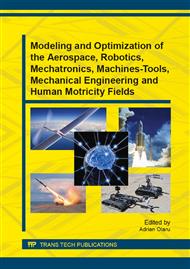p.135
p.147
p.155
p.163
p.170
p.178
p.186
p.192
p.199
Analysis of the Accuracy and Robustness of Kinect Sensor Used with the Scope of Robot Manipulation
Abstract:
This paper describes in details the evaluation procedure developed in this paper for the measurement of the Kinect sensors accuracy and robustness in the detection process of the user hand and recognizing human hand gestures. Furthermore, the results are transferred to a robotic gripper in virtual environment for visualization. The research started with consideration on the current state of the methods and sensors used for the detection of the hand gestures. It was seen that the detection of human hand and gestures recognition represent an important research study in the field of robotics controls and automation. Through the time, different methods [7, 13] and sensors [12] were developed for the action of detection which became, with the passing of time, better and better, reaching today, a point, when Kinect sensor was constructed as a combination between mature sensor technology and efficient algorithms for detection. The goal of this paper is represented by the analysis, if the XBox 360 (TM) Kinect sensor, developed by Microsoft, is accurate enough to be used as a mean to control a robotic hand in virtual environment. To find this out, the main objectives of this paper represents the measurement of the accuracy of Kinect sensor action for the capture of gestures performed by a human hand in a repeatable manner. As a second objective, in order to be able to visualize the result, the gestures are translated into virtual environment. In order achieve the main scope of this paper, two metrics were defined, according to ISO standard for measurement. Those are: Accuracy/Precision using ISO 5725: 1994 [16] Repeatability - ISO 21748: 2010 [17] The result of the captured hand posture with the highest accuracy are then moved to a robotic hand simulated in virtual environment executing an object grasping and releasing.
Info:
Periodical:
Pages:
170-177
Citation:
Online since:
June 2014
Authors:
Price:
Сopyright:
© 2014 Trans Tech Publications Ltd. All Rights Reserved
Share:
Citation:


